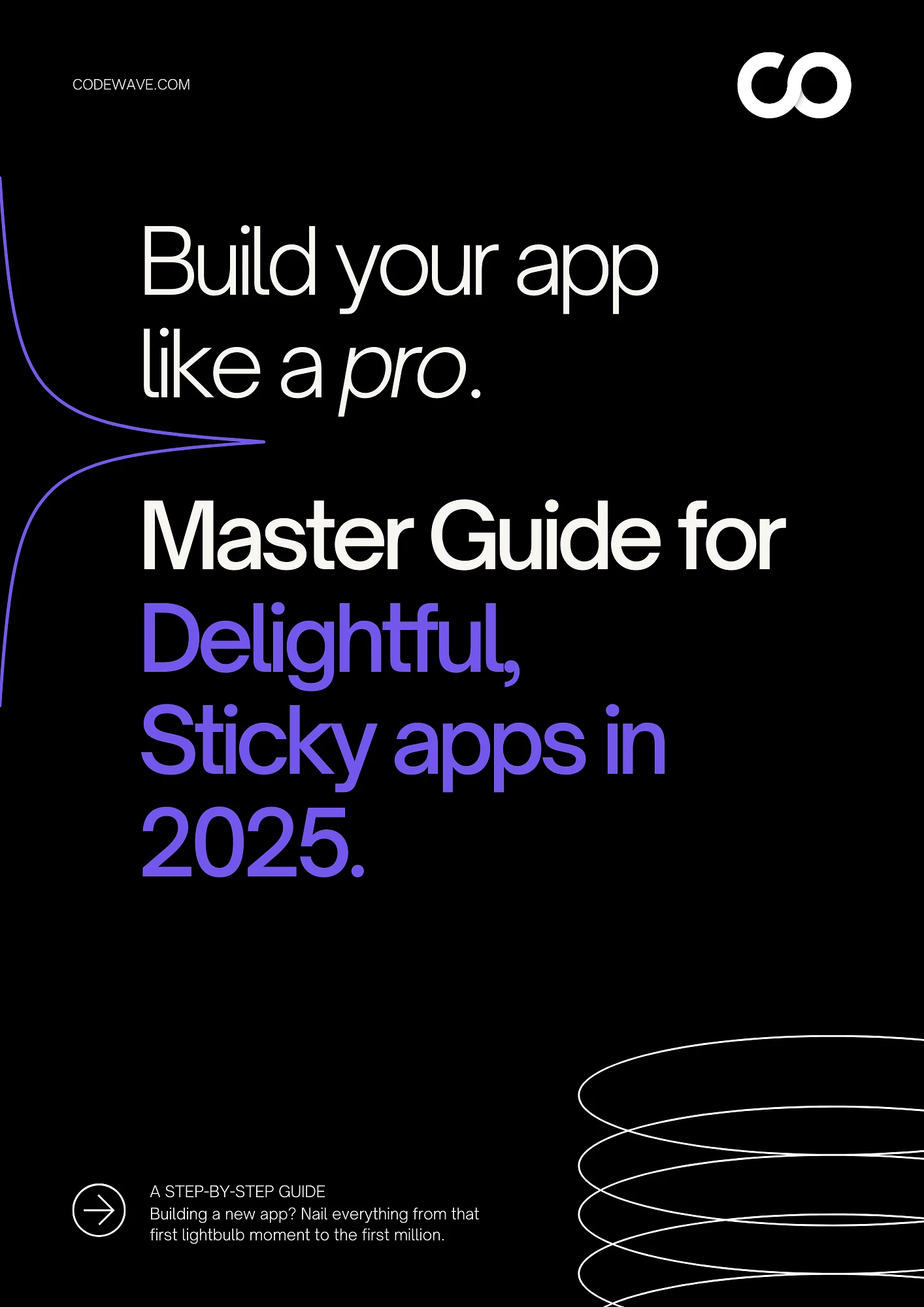Nine out of ten startups fail because they invest too much, too early, in the wrong direction. Startup Genome reports that 74% scale prematurely before validating their product, while research shows that 42% of startups fail because there is no market need.
These numbers show that too many entrepreneurs build products on assumptions, not data. That’s where the Lean Startup methodology changes the game.
In this blog, we’ll explore how the Lean Startup framework works, its key principles like the Build–Measure–Learn loop and Minimum Viable Product (MVP), and why it’s essential.
Key Takeaways
- Stop wasting resources on unproven ideas. Lean Startup helps founders validate assumptions early, saving time and capital that would otherwise be spent building features no one needs.
- Learn fast from real users. Through the Build–Measure–Learn loop, you test small, collect feedback, and adjust, turning uncertainty into actionable insight.
- Launch faster, with less risk. A Minimum Viable Product (MVP) helps you enter the market quickly, test traction, and evolve based on real data instead of guesswork.
- Make data your strategy. Continuous experimentation ensures every decision, from feature design to scaling, is backed by evidence, not assumptions.
- Scale smart with technology. Partnering with the right tech team enables faster prototyping, automated feedback loops, and sustainable growth grounded in real user validation.
What is the Lean Startup Methodology?
The Lean Startup methodology is a structured approach to building new products or businesses through rapid experimentation, real customer feedback, and continuous improvement. Developed by Eric Ries, it replaces long business plans with short, testable cycles that focus on learning what works before scaling.
Teams build a Minimum Viable Product (MVP), measure real-world results, and learn from user feedback to refine or pivot quickly. Waste reduction, early assumption validation, and market-driven product development are the goals.
With the foundation in place, the next step is to explore the principles that make this approach practical and measurable for startups and innovation teams.
Must Read: Building Applications in the Cloud: A Step-By-Step Guide
Core Principles of the Lean Startup
The Lean Startup methodology operates on five core principles designed to help businesses validate ideas faster and reduce waste.
1. Build–Measure–Learn Feedback Loop
This loop is the foundation of the Lean Startup approach. Teams build a small, testable version of the product, measure real user responses, and learn what works or doesn’t. The process helps make early, informed decisions and prevents large-scale failures.
2. Minimum Viable Product (MVP)
An MVP is the simplest version of a product built to test a core idea quickly. It allows entrepreneurs to validate assumptions with real users before committing full resources. Even a basic prototype or landing page can reveal valuable insights about market demand.
3. Validated Learning
Validated learning focuses on gathering evidence instead of relying on opinions. Each experiment aims to learn something specific about the product, customer, or business model. It ensures progress is based on real data, not assumptions.
4. Pivot or Persevere
After reviewing data and feedback, teams must decide whether to keep improving the current product or change direction. A pivot might involve adjusting features, pricing, or target users. This principle helps businesses focus only on ideas that show real potential.
5. Innovation Accounting
Innovation accounting tracks learning, not downloads or revenue. Customer engagement and validated hypotheses are milestones. This keeps teams focused on long-term success and meaningful growth.
These five principles show that the Lean Startup isn’t just for early-stage founders; it’s a blueprint for how every modern digital business can innovate with less risk and more clarity.
Must Read: Microservices architecture for eCommerce application development
Why Lean Startup Matters for Digital Products & Innovation?
The Lean Startup approach plays a vital role in how modern digital products are designed, tested, and scaled. It gives teams a structured way to innovate quickly while minimizing risk and cost.
1. Faster Adaptation in a Rapidly Changing Market
- Real-time user needs, technology, and competition shape digital products.
- The Lean approach enables rapid experimentation so teams can respond quickly instead of being locked into long development cycles.
- It helps businesses stay relevant and competitive by learning directly from customer behavior.
2. Smarter Product Development
- By focusing on MVPs and real-world testing, teams can validate core features before full-scale investment.
- This eliminates unnecessary complexity and ensures that every line of code or design decision adds measurable value.
- Digital teams can align design, development, and analytics around clear user feedback loops.
3. Reduced Risk and Better Resource Utilization
- Lean Startup prevents overbuilding by testing only what’s essential.
- Each iteration provides concrete data, allowing teams to prioritize the features or improvements that drive real impact.
- This approach optimizes time, talent, and capital, which startups and SMEs need.
4. Continuous Innovation Through Learning
- Every build–measure–learn cycle generates new insights that guide product evolution.
- Teams can pivot, improve, or expand based on validated results rather than assumptions.
- Over time, this creates a culture of ongoing innovation and adaptability.
5. Foundation for Scalable Digital Transformation
- Lean principles naturally align with agile and design thinking, making them ideal for enterprise digital transformation.
- As digital products mature, this methodology supports scalable architecture, automation, and user experience optimization.
- It transforms innovation from a one-time effort into a repeatable, measurable process.
While the benefits are clear, many teams struggle with implementation. Here, a structured, collaborative approach with the right technology partner makes all the difference.
Your product data holds the blueprint for growth. Codewave helps startups measure what matters, from MVP validation to full-scale digital transformation.
How Entrepreneurs Can Apply Lean Startup With a Technology Partner?
Practicing Lean Startup requires the right mindset and technical support. With a reliable technology partner, entrepreneurs can quickly prototype ideas, gather insights, and scale while staying lean and data-driven.
1. Define the Problem and Hypothesis
Every great product starts with a clearly defined problem.
- Identify your target user, their core pain point, and the measurable outcome you want to achieve.
- Frame a hypothesis such as: “If we build this feature, it will solve this user challenge.”
- A technology partner can help validate this hypothesis through market research, design discovery sessions, and technical feasibility checks before development begins.
Example: A fitness startup hypothesizes that users struggle to maintain workout consistency. With help from their tech partner, they test whether adding AI-generated workout reminders improves daily engagement rates.
2. Build a Minimum Viable Product (MVP)
An MVP is the simplest functional version of your product used to test the hypothesis.
- Instead of building a full platform, create just enough functionality to observe real user behavior.
- Partners often use rapid prototyping, low-code platforms, or design sprints to help founders visualize and test ideas within days, not months.
- The goal is to collect meaningful insights early, not to launch a perfect product.
Example: An edtech founder launches a single-course pilot app instead of a full platform to test whether students engage more with gamified lessons. The tech partner builds this MVP within two weeks using a low-code framework.
3. Measure What Matters
Once the MVP is in users’ hands, focus on gathering the right data.
- Set up key performance indicators (KPIs) that measure user engagement, activation, retention, or conversion.
- A technology team can help integrate analytics tools, dashboards, and feedback loops to ensure decisions are data-backed.
- Avoid vanity metrics; prioritize metrics that show whether the product is solving a real user problem.
Example: A food delivery startup measures whether AI-based menu suggestions increase repeat orders. Instead of tracking downloads, they monitor “orders per returning user” to validate actual impact.
4. Learn, Pivot, or Persevere
After analyzing the data, decide whether to pivot (change direction) or persevere (improve what works).
- A pivot might mean redesigning a feature, targeting a new audience, or adjusting your pricing model.
- The key is to treat every iteration as an experiment, not a setback.
- A collaborative partner can accelerate this learning process by quickly adapting design and code based on feedback.
Example: A travel app discovers through user feedback that people prefer planning weekend trips, not full vacations. The startup pivots, focusing on short-trip recommendations, which saves time and redirects resources effectively.
5. Scale With Confidence
Once validation is achieved, it’s time to strengthen the product for scale.
- Improve infrastructure, UX, and performance as you move from prototype to production.
- Ensure your technology stack supports automation, analytics, and scalability to handle future growth.
- Continue applying the Lean principle: build small, test fast, and iterate continuously.
Example: An AI recruitment startup moves from prototype to production by migrating to a cloud-based architecture with autoscaling and advanced analytics. This allows them to serve 10× more users while maintaining response time under two seconds.
These indicators show whether your experiments are driving measurable business value.
Applying the Lean methodology is only the first step. To ensure you’re learning effectively and making measurable progress, you’ll need to track the right performance indicators at each stage.
Ready to validate your idea faster? Partner with Codewave to turn your Lean Startup experiments into market-ready prototypes.
Must Read: Serverless tech to run your business on the cloud
Key Performance Indicators and Metrics for Lean Startups in Digital Projects
In a Lean Startup, success is measured by learning, not building. Tracking the right KPIs ensures every experiment yields actionable insights.
Digital product teams should track these metrics throughout their Lean journey.
1. Time to MVP Launch
- Measures how quickly a product idea is turned into a working prototype.
- Shorter cycles indicate faster learning and efficient collaboration.
- Ideal range: 2–6 weeks for most digital products.
2. Customer Validation Rate
- Represents the percentage of hypotheses confirmed through real user feedback.
- For example, if 5 of 8 tested assumptions are validated, the rate is 62.5%.
- A high validation rate means the team is building features that users actually value.
3. Activation and Retention Metrics
- Activation rate: Measures how many users take the first key action (e.g., signing up, uploading, or purchasing).
- Retention rate: Tracks how many users return or stay engaged after the first use.
- These metrics indicate whether the MVP delivers enough value to keep users interested.
4. Cost per Validated Learning
- Calculates the total spend divided by the number of validated insights gained.
- Lower costs show efficient experimentation and resource management.
- Useful for evaluating whether development cycles are lean or wasteful.
5. Iteration Velocity
- Tracks how many build–measure–learn cycles are completed within a specific timeframe.
- A higher iteration rate reflects an agile, responsive team continuously learning from data.
- Example: 3 validated learning loops per month signal steady innovation.
6. Customer Acquisition Cost (CAC) vs. Lifetime Value (LTV)
- CAC: The cost of acquiring one paying customer.
- LTV: The projected revenue from that customer over time.
- Maintaining a healthy LTV-to-CAC ratio (typically above 3:1) ensures the product can scale sustainably.
Metrics guide growth, but execution defines it. Even with the best tools and frameworks, startups often face roadblocks when applying Lean principles in real-world conditions.
Must Read: 5 Things to do when building your company’s website
Common Mistakes and How to Avoid Them
The Lean Startup approach is powerful, but many teams struggle to use it effectively. Misunderstanding its principles often leads to wasted effort, missed insights, and poor decisions.
Here are some common pitfalls that can derail Lean execution.
1. Building Too Much, Too Soon
Many founders overbuild their first MVP to make it look complete. Instead of perfecting every feature before validation, an MVP tests one key assumption quickly.
2. Ignoring Customer Feedback
Some teams rely too heavily on internal opinions or assumptions instead of actual user data. Lean Startup only works when feedback from real users directly shapes each product iteration.
3. Measuring Vanity Metrics Instead of Real Learning
Counting downloads or page views is impressive but not useful. Validated learning data that proves the product solves a real customer problem is crucial.
4. Misinterpreting “Fail Fast”
Failing fast doesn’t mean skipping research or cutting corners. It means designing small, structured experiments that generate insights quickly and safely before scaling.
5. Lacking Alignment Between Teams
If design, engineering, and business teams don’t share the same goals, the feedback loop breaks down. Successful Lean execution depends on open communication and shared ownership of learning outcomes.
6. Neglecting Long-Term Scalability
Startups often stop refining once they achieve early traction, ignoring the need for scalability. Lean practices should evolve into sustainable systems that can support growth once product-market fit is reached.
7. Over-Pivoting Without Data
Changing direction repeatedly without solid evidence causes confusion and wasted time. Pivots should only happen when data clearly proves the current approach isn’t viable.
Avoiding these pitfalls is essential, but doing it consistently requires experience and technical precision. That’s where Codewave’s design-thinking-led development approach comes into play.
How Codewave Empowers Founders to Build Lean, Launch Fast, and Scale Smart?
Codewave helps founders and product teams apply Lean Startup principles in real-world development, combining design thinking, agile engineering, and data-led decision-making to turn early ideas into market-ready innovations.
1. Turning Ideas Into Testable Prototypes
Every successful product begins as an assumption. Codewave transforms these assumptions into tangible prototypes using rapid design sprints and low-code development tools. Within days, entrepreneurs can visualize core features, test functionality, and gather user feedback without heavy investment.
2. Building Minimum Viable Products (MVPs) That Learn Fast
Codewave develops MVPs, the simplest, functional versions that provide measurable learning, instead of full-scale products. This helps teams validate market demand, identify user needs, and refine product direction using evidence, not intuition.
3. Data-Driven Feedback and Continuous Learning
Once an MVP is live, Codewave helps capture actionable insights through analytics integration, A/B testing, and user journey tracking. Each data point becomes a learning opportunity, guiding decisions on whether to pivot, enhance, or scale the product.
4. Scaling With Intelligent Architecture
After validation, scaling becomes the next challenge. Codewave ensures digital products are built on scalable, cloud-ready, and automation-driven architecture, enabling fast iteration and smooth expansion. The focus is on maintaining agility while growing sustainably.
5. Accelerating Growth Through Design Thinking
Every Codewave engagement centers on design thinking, its key differentiator. The company ensures each solution works efficiently and impacts users emotionally by aligning business goals, user experience, and technical feasibility.
6. Delivering Measurable Business Outcomes
With over 400+ successful projects across 15 countries, Codewave’s approach blends lean innovation with real-world scalability. Founders benefit from faster market entry, stronger product-market fit, and long-term digital maturity.
Must Read: When To Use MongoDB and Why? – Codewave Insights
Conclusion
The Lean Startup mindset builds smarter, faster, and more resilient digital products. In a digital-first world where speed and adaptability define success, the combination of Lean principles, design thinking, and agile engineering helps turn uncertainty into structured growth.
It enables businesses to move beyond guesswork, creating products that evolve continuously through feedback and data.
Ready to build lean and launch faster? Explore Codewave’s portfolio to see how visionary founders and enterprises are shaping the future through design-led digital innovation.
FAQs
1. How do I know if the Lean Startup approach is right for my business?
The Lean Startup method is ideal for new ventures or product teams operating under uncertainty. If you’re still validating your market, customer needs, or business model, Lean principles help you minimize risk through fast experimentation and feedback.
2. What skills or team structure do I need to implement Lean Startup effectively?
Collaboration between product management, design, engineering, and analytics makes a Lean team successful. Being flexible enough to test, fail, and iterate based on data rather than plans is key.
3. How can Lean Startup be combined with Agile or Design Thinking?
Lean Startup defines what to build (validated learning), Agile defines how to build efficiently, and Design Thinking defines why it matters to users. They create a powerful product innovation cycle from user empathy to rapid delivery and continuous improvement.
4. How often should startups run Build–Measure–Learn cycles?
Frequency depends on complexity and team size. However, high-performing digital teams aim for one validated learning cycle every 2–4 weeks to ensure steady progress and timely pivots.
Codewave is a UX first design thinking & digital transformation services company, designing & engineering innovative mobile apps, cloud, & edge solutions.







